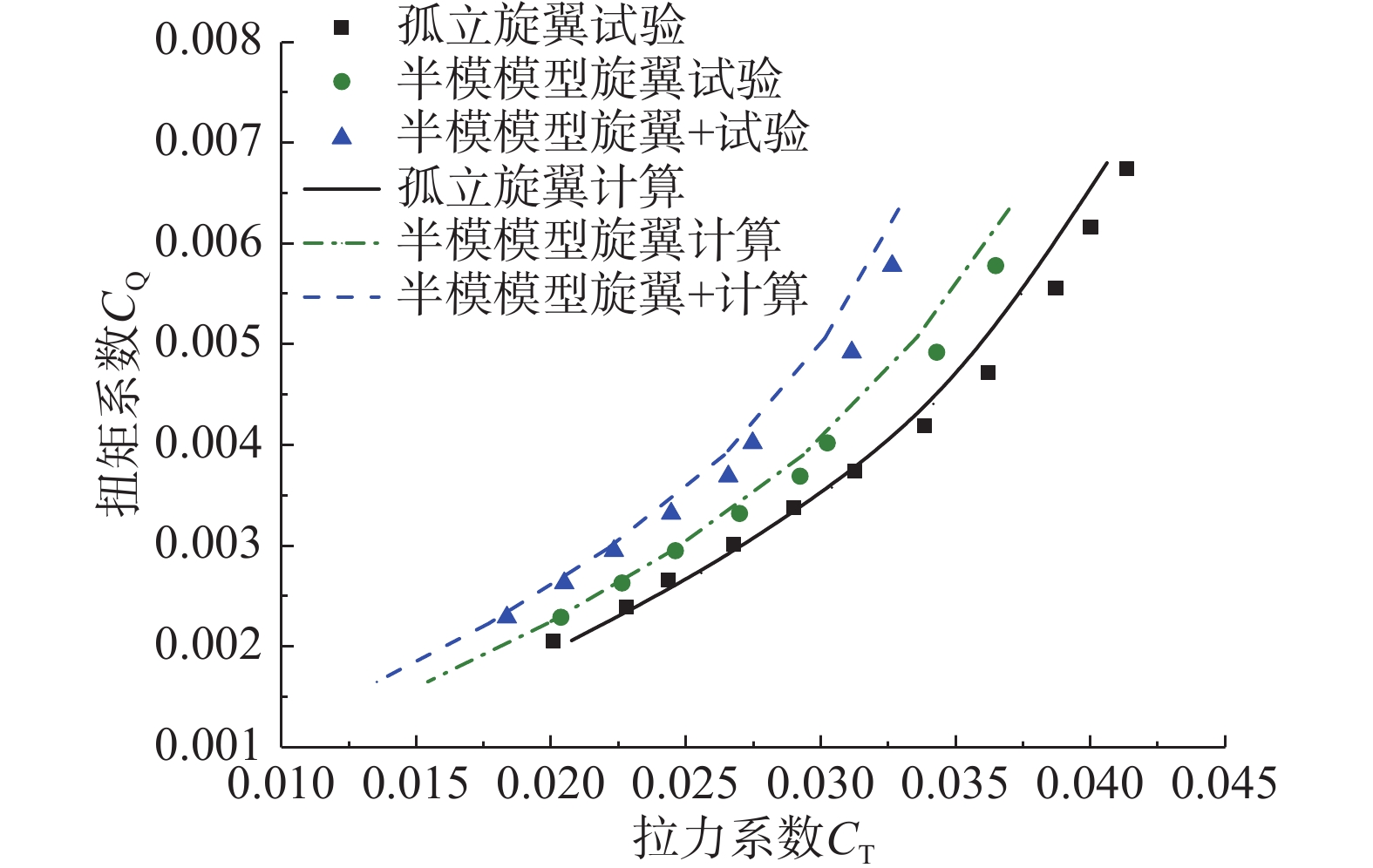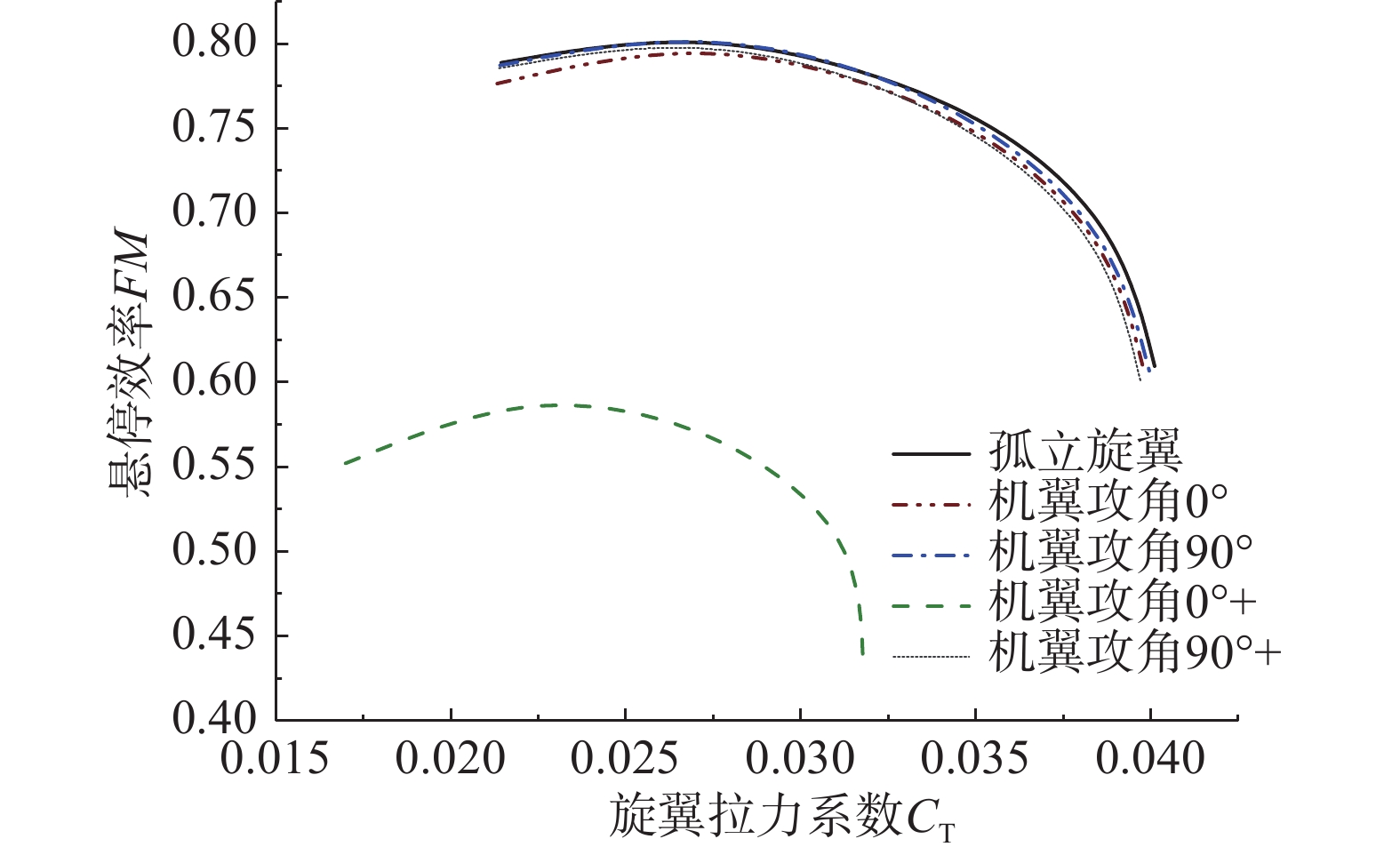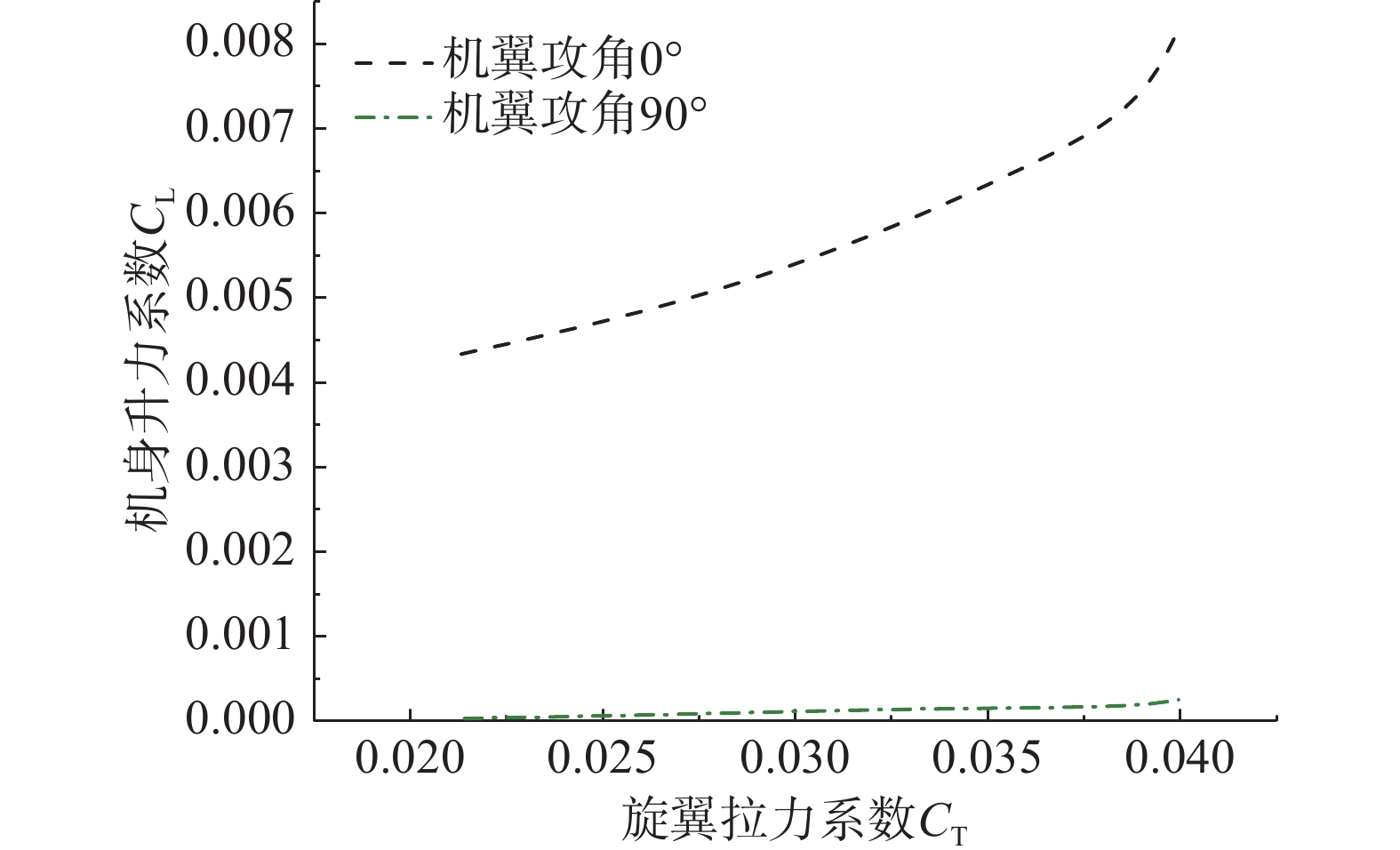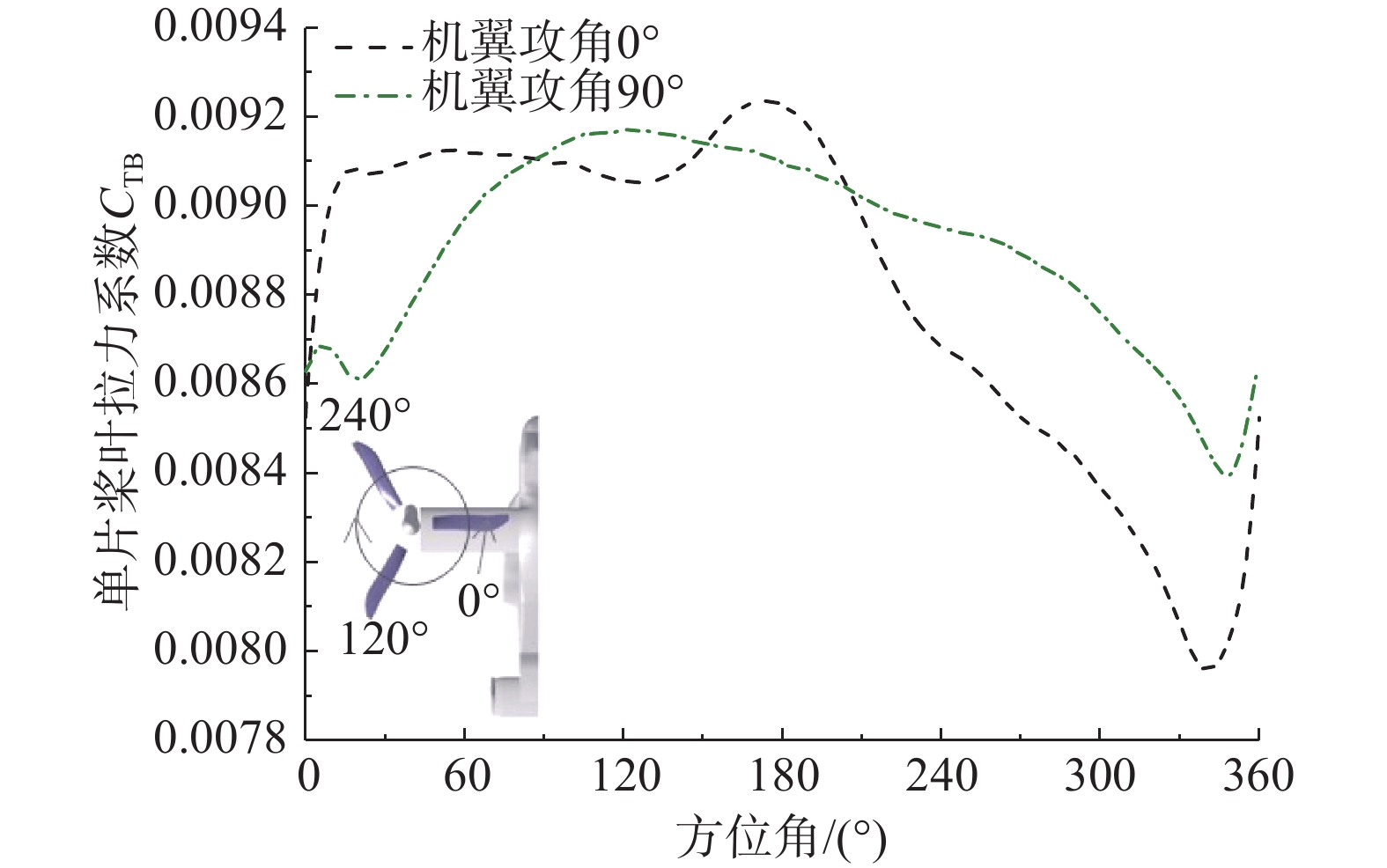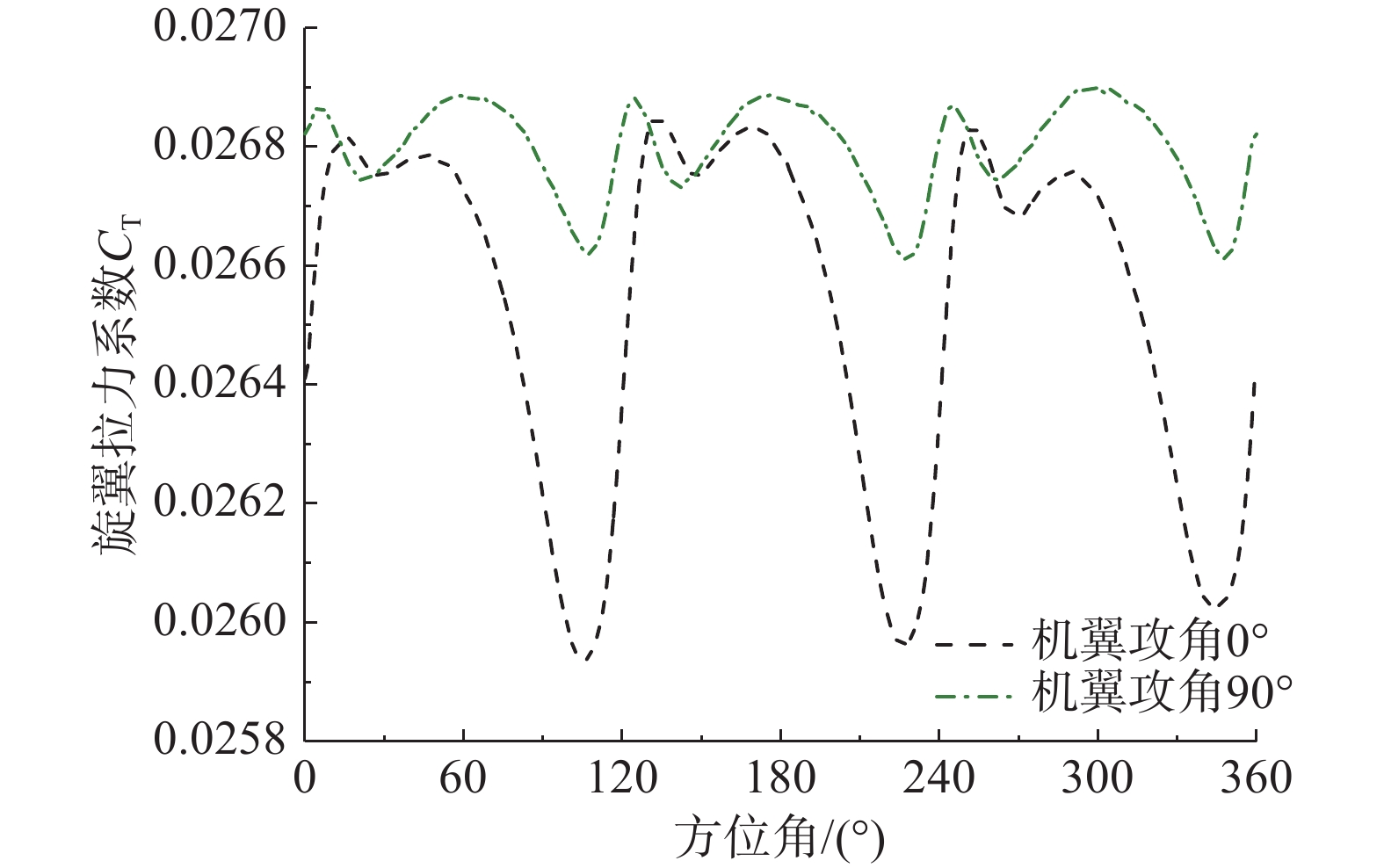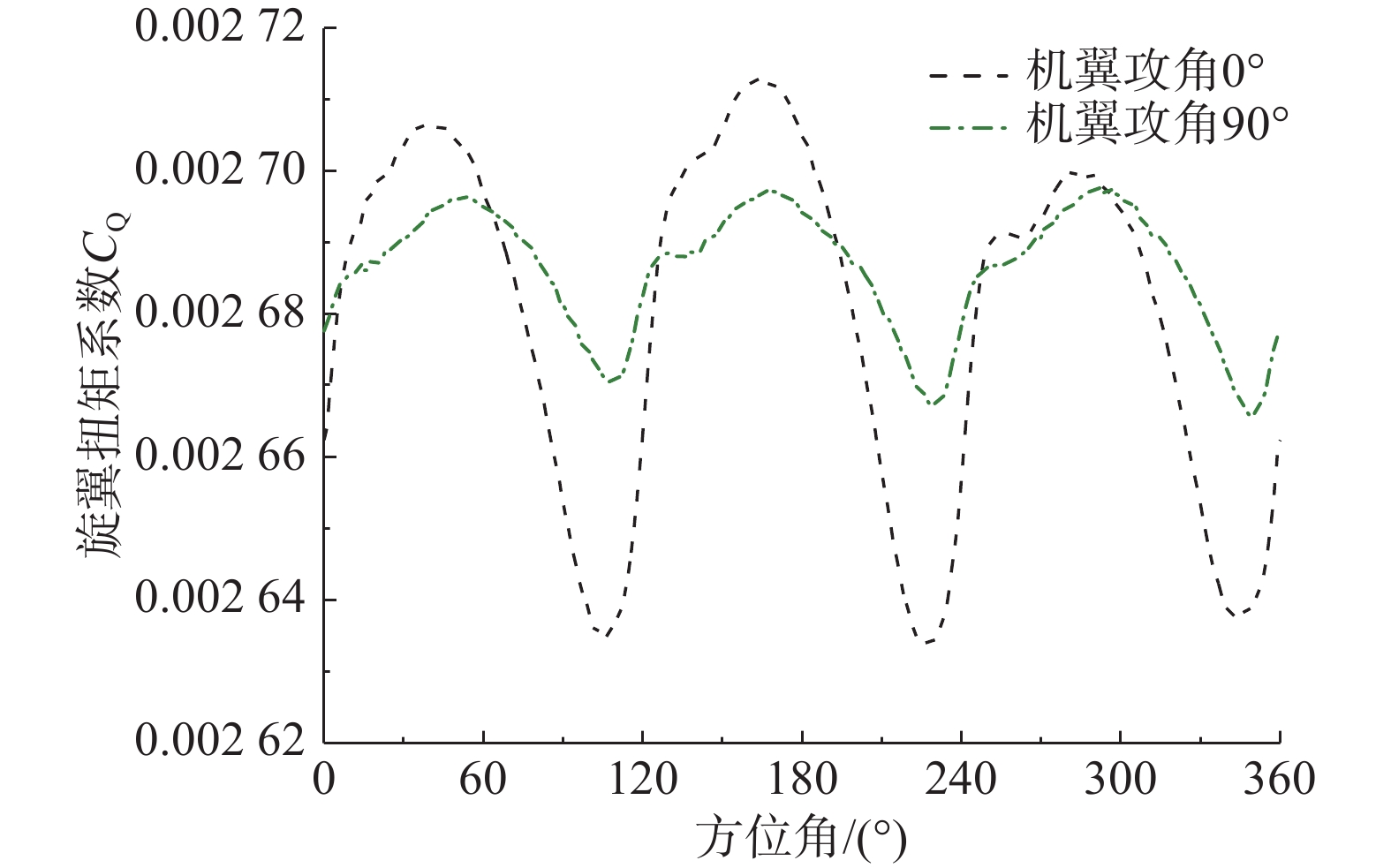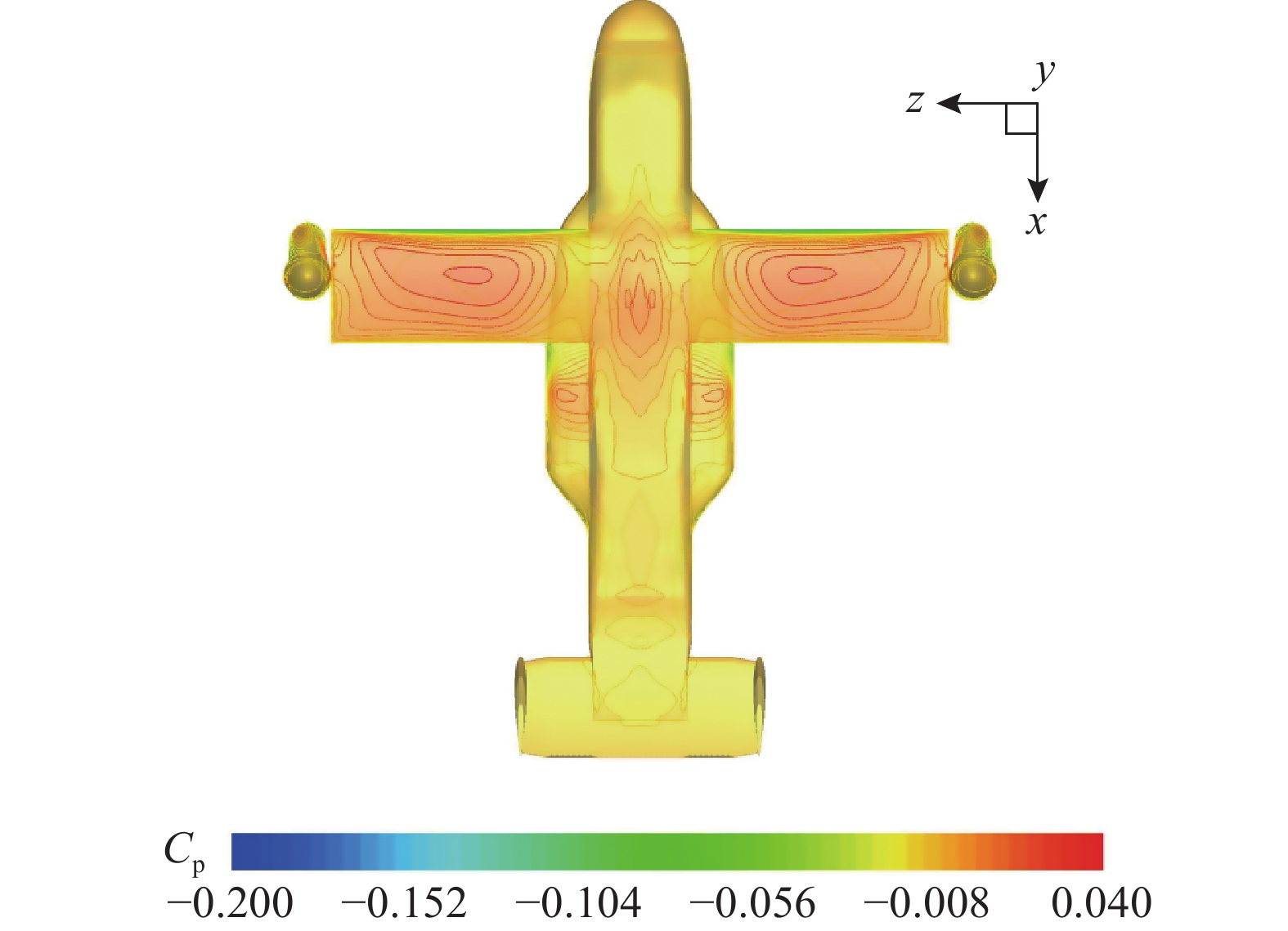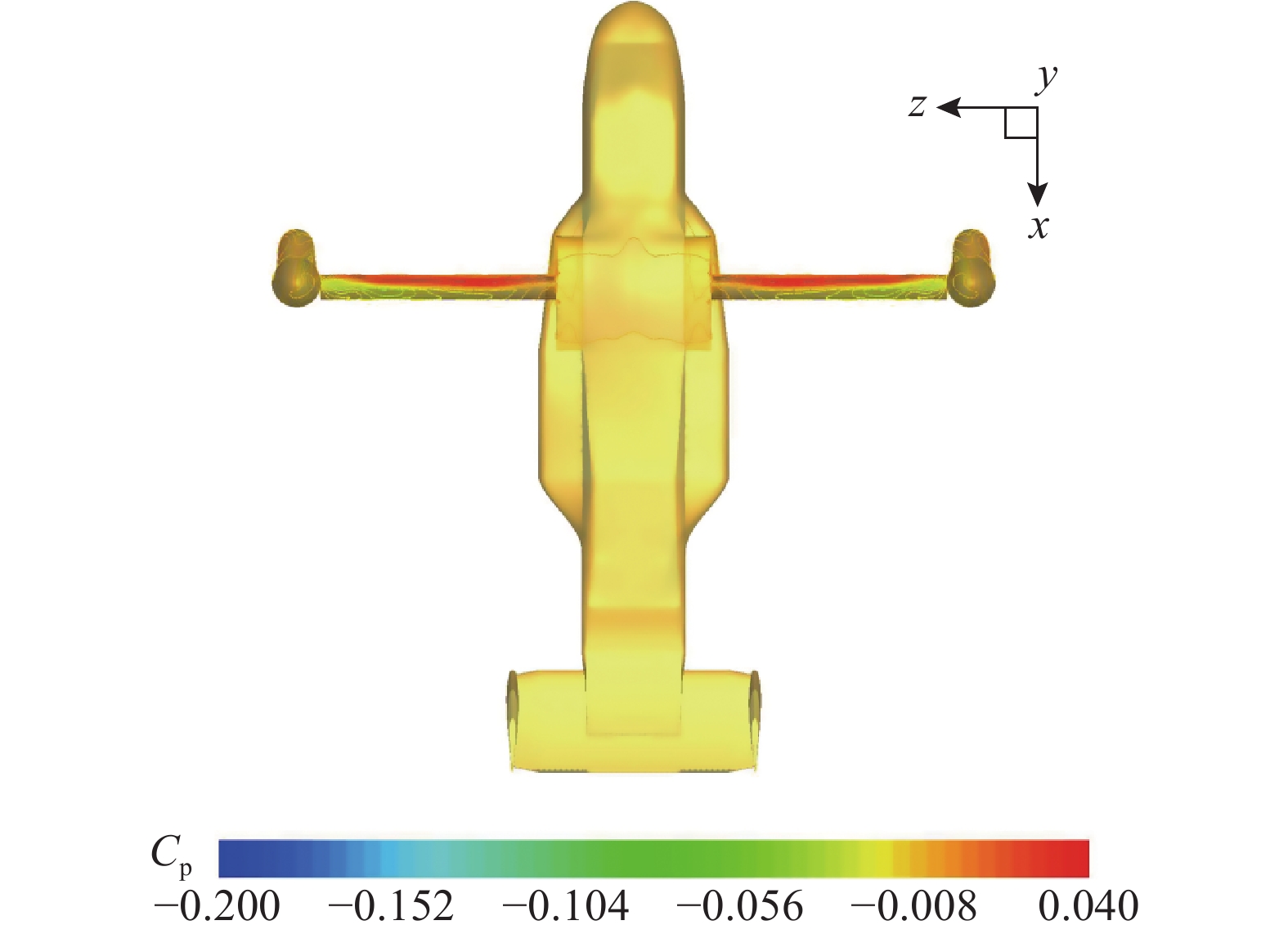THE ANALYSIS OF AERODYNAMIC INTERFERENCE OF TILT ROTOR AIRCRAFT IN HOVER
-
摘要:
针对倾转旋翼机,开展了悬停状态气动干扰风洞试验和数值模拟研究。试验中,测量了悬停状态下的旋翼升力、扭矩以及半模机翼的气动力。同时,采用运动嵌套网格方法,通过求解N-S方程对机翼倾角0°和90°两种状态进行数值模拟,开展了数值模拟与风洞试验的相关性分析研究,验证了该数值模拟方法的有效性。结果表明:不考虑机身气动力时,孤立旋翼、机翼攻角0°和机翼攻角90°三种状态下旋翼气动特性差异不明显;考虑机身气动力时,机翼攻角0°时,机身产生约18.2%向下载荷,单片桨叶和机身出现强烈非定常气动特性,其中桨叶升力系数动态值与平均值比为9.8%,机身升力系数动态值与平均值比为18.38%。
Abstract:A wind tunnel test and numerical simulation of aerodynamic interference in hover are carried out for tiltrotor aircraft. In the test, the rotor lift, torque and aerodynamic force of half model wing are measured. At the same time, the moving overset grids method is used to numerically simulate the two states of Isorotor, wing angle of attack 0° and 90°, by solving the N-S equation. The correlation between numerical simulation and wind tunnel test is carried out to verify the effectiveness of the numerical simulation method. The results show that when the aerodynamic force of fuselage is not considered, the difference of rotor aerodynamic characteristics is not obvious under the three states; when the aerodynamic force of fuselage is considered, in the wing angle of attack 0° state, the fuselage generates about 18.2% downward load, the single blade and fuselage have strong unsteady aerodynamic characteristics, in which the ratio of dynamic value to average value of single blade lift coefficient is 9.8%, and the ratio of dynamic value to average value of fuselage lift coefficient is 18.38%.
-
Keywords:
- tiltrotor aircraft /
- aerodynamic interference /
- wind tunnel test /
- numerical simulation /
- hover
-
-
表 1 天平标定系数表
Table 1 Balance calibration coefficient
变量 旋翼天平 x方向力Fx y方向力Fy z方向力Fz x向力矩Mx y向力矩My z向力矩Mz Fx 0 4.099×10-2 2.246×10−1 9.297×10−3 −5.394×10−2 −2.148 Fy 8.296×10−3 0 3.785×10−2 1.971×10−3 −1.451×10−3 8.502×10−3 Fz −3.530×10−3 9.169×10−2 0 −2.167 −2.481×10−2 1.167×10−2 Mx 1.657×10−2 7.826×10−2 1.079×10−1 0 1.255×10−2 3.766×10−2 My −1.628×10−1 −8.071×10−2 −1.373 7.355×10−5 0 −6.806×10−2 Mz −4.286×10−2 −7.983×10−2 1.010×10−1 3.089×10−2 −6.227×10−2 0 ΔUx 9.645 0 0 0 0 0 ΔUy 0 9.847 0 0 0 0 ΔUz 0 0 9.909 0 0 0 ΔUMx 0 0 0 1.571 0 0 ΔUMy 0 0 0 0 1.027 0 ΔUMz 0 0 0 0 0 1.577 变量 机翼天平 x向力Fx y向力Fy z向力Fz x向力矩Mx y向力矩My z向力矩Mz Fx 0 −7.919×10−3 2.472×10−3 0 −4.684×10−2 6.551 Fy 0 0 1.964×10−4 −1.841×10−1 0 0 Fz −5.022×10−2 −7.742×10−2 0 1.419×101 6.984×10−2 0 Mx 0 −3.017×10−2 1.521×10−1 0 0 −8.800×10−2 My 0 0 9.521×10−2 0 0 −4.837×10−2 Mz 3.004×10−2 −4.564×10−3 2.520×10−3 0 0 0 ΔUx 1.101×101 0 0 0 0 0 ΔUy 0 1.509×101 0 0 0 0 ΔUz 0 0 1.499×101 0 0 0 ΔUMx 0 0 0 1.887 0 0 ΔUMy 0 0 0 0 2.270 0 ΔUMz 0 0 0 0 0 3.390 表 2 重复性试验
Table 2 Repeatability test results
试验次数 拉力系数CT 扭矩系数CQ 升力系数CL 1 0.029 134 0.003 702 0.002 672 6 2 0.029 356 0.003 676 0.002 671 8 3 0.029 151 0.003 677 0.002 654 0 4 0.029 297 0.003 698 0.002 668 9 5 0.029 122 0.003 679 0.002 652 9 6 0.029 373 0.003 694 0.002 673 2 7 0.029 174 0.003 673 0.002 654 8 最大相对误差/(%) 0.491 0.446 0.418 表 3 拉力系数与机身升力系数对比
Table 3 Comparison between CT and CL of fuselage
总距φ7/(°) 机翼攻角0° 拉力系数CT 机身升力系数CL CL/CT/(%) 12 0.026 589 0.004 872 18.32 14 0.031 391 0.005 598 17.83 16 0.035 610 0.006 451 18.12 18 0.038 865 0.007 199 18.52 平均值 18.20 总距φ7/(°) 机翼攻角90° 拉力系数CT 机身升力系数CL CL/CT/(%) 12 0.026 698 0.000 080 0.30 14 0.031 587 0.000 133 0.42 16 0.035 749 0.000 157 0.44 18 0.038 959 0.000 177 0.45 平均值 0.40 表 4 平均值与动态值对比
Table 4 comparison between average value and dynamic value
变量 机翼攻角0° 单片桨叶拉力
系数CTB拉力系数
CT扭矩系数
CQ机身升力
系数CL平均值 0.008 823 2 0.026 531 7 0.002 679 5 0.004 861 7 动态值 0.000 864 7 0.000 594 3 0.000 045 7 0.000 893 7 动态值与
平均值比值/(%)9.80 2.24 1.71 18.38 变量 机翼攻角90° 单片桨叶拉力
系数CTB拉力系数
CT扭矩系数
CQ机身升力
系数CL平均值 0.008 909 8 0.026 795 4 0.002 686 2 0.000 098 9 动态值 0.000 516 0.000 185 9 0.000 020 5 0.000 325 8 动态值与
平均值比值/(%)5.79 0.69 0.76 329.49 -
[1] TUNG C, BRANUM L. Model tilt rotor hover performance and surface pressure measurement [C]. Washington: American Helicopter Annual Forum, 1990: 785 − 796.
[2] JOHNSON W. Calculation of the aerodynamic behavior of the tilt rotor aeroacoustic model (TRAM) in the DNW [C]. Washington: American Helicopter Annual Forum, 2001: 1344 − 1380.
[3] FEJTEK I, ROBERTS L. Navier-stokes computation of wing/rotor interaction for a tilt rotor in hover [J]. AIAA Journal, 1992, 30(11): 2595 − 2603. doi: 10.2514/3.11272
[4] MEAKIN R L. Unsteady simulation of the viscous flow about a V-22 rotor and wing in hover [C]. Baltimore: Atmospheric Flight Mechanics Conference, 1995: 332 − 344.
[5] DROANDI G, ZANOTTI A, GIBERTINI G. Experimental investigation on a 1/4 scaled model of an high- performance tiltwing aircraft in hover [C]. Montreal: AHS Annual Forum, 2014: 1 − 15.
[6] POSTSDAM M A, STRAWN R C. CFD simulations of tiltrotor configurations in hover [J]. Journal of American Helicopter Society, 2005, 50(1): 82 − 94. doi: 10.4050/1.3092845
[7] DROANDI G, GIBERTINI G, GRASSI D, et al. Proprotor-wing aerodynamic interaction in the first stages of conversion from helicopter to aeroplane mode [J]. Aerospace Science and Technology, 2016, 58: 116 − 133. doi: 10.1016/j.ast.2016.08.013
[8] TAKII A, YAMAKAWA M, ASAO S, et al. Turning flight simulation of tilt-rotor plane with fluid-rigid body interaction [J]. Journal of Thermal Science and Technology, 2020, 15(2): JTST0021. doi: 10.1299/jtst.2020jtst0021
[9] ZANOTTI A, SAVINO A, PALAZZI M, et al. Assessment of a mid-fidelity numerical approach for investigation of tiltrotor aerodynamics [J]. Applied Sciences, 2021, 11(8): 3385. doi: 10.3390/app11083385
[10] YOUNG L A. Tilt rotor aeroacoustic model (TRAM) a new rotorcraft research facility [C]. Gifu: AHS International Meeting on Advanced Rotorcraft Technology and Disaster Relief, 1998: 4401 − 4411.
[11] MCCLUER M S, JOHNSON J L. Full-span tiltrotor aeroacoustic model (FS TRAM) overview and initial testing [C]. San Francisco: American Helicopter Society Aerodynamics, Acoustics and Test and Evaluation Technical Specialists’ Meeting, 2002: 1 − 17.
[12] 高永卫. 螺旋桨噪声特性风洞实验和数值模拟技术研究[D]. 西安: 西北工业大学, 2004. GAO Yongwei. Research on wind tunnel test and numerical simulation of propeller noise characteristics [D]. Xi’an: Northwest University of Technology, 2004. (in Chinese)
[13] 李尚斌, 焦予秦. 基于翼尖支撑和螺旋桨独立支撑的螺旋桨滑流影响实验研究[J]. 工程力学, 2013, 30(7): 288 − 293. doi: 10.6052/j.issn.1000-4750.2012.04.0243 LI Shangbin, JIAO Yuqin. The test investigation of the effect of propeller slipstream based on Wing-Tip support and indepent propeller support [J]. Engineering Mechanics, 2013, 30(7): 288 − 293. (in Chinese) doi: 10.6052/j.issn.1000-4750.2012.04.0243
[14] 王适存, 徐国华. 直升机旋翼空气动力学的发展[J]. 南京航空航天大学学报, 2001, 33(3): 203 − 211. doi: 10.3969/j.issn.1005-2615.2001.03.001 WANG Shicun, XU Guohua. Progress of helicopter rotor aerodynamics [J]. Journal of Nanjing University of Aeronautics &Astronautics, 2001, 33(3): 203 − 211. (in Chinese) doi: 10.3969/j.issn.1005-2615.2001.03.001
[15] 李正农, 冯豪, 浦鸥, 等. 基于六旋翼无人机搭载风速仪的边界层风剖面实测研究[J]. 工程力学, 2021, 38(8): 121 − 132. doi: 10.6052/j.issn.1000-4750.2020.08.0553 LI Zhengnong, FENG Hao, PU Ou, et al. Boundry layer wind profile measurement based on a six-rotor UAV anemometer [J]. Engineering Mechanics, 2021, 38(8): 121 − 132. (in Chinese) doi: 10.6052/j.issn.1000-4750.2020.08.0553
[16] 安朝, 谢长川, 孟杨, 等. 多体组合式无人机飞行力学稳定性分析及增稳控制研究[J]. 工程力学, 2021, 38(11): 248 − 256. doi: 10.6052/j.issn.1000-4750.2020.11.0820 AN Chao, XIE Changchuan, MENG Yang, et al. Flight dynamics and stable control analyses of multi-body aircraft [J]. Engineering Mechanics, 2021, 38(11): 248 − 256. (in Chinese) doi: 10.6052/j.issn.1000-4750.2020.11.0820
[17] 李春华, 徐国华. 悬停和前飞状态倾转旋翼机的旋翼自由尾迹计算方法[J]. 空气动力学学报, 2005, 23(2): 152 − 156. doi: 10.3969/j.issn.0258-1825.2005.02.004 LI Chunhua, XU Guohua. The rotor free-wake analytical method for tiltrotor aircraft in hover and forward flight [J]. Acta Aerodynamica Sinica, 2005, 23(2): 152 − 156. (in Chinese) doi: 10.3969/j.issn.0258-1825.2005.02.004
[18] 李鹏, 招启军. 悬停状态倾转旋翼/机翼干扰流场及气动力的CFD计算[J]. 航空学报, 2014, 35(2): 362 − 370. LI Peng, ZHAO Qijun. CFD calculations on the interaction flowfield and aerodynamic force of tiltrotor/wing in hover [J]. Acta Aeronautica ET Astronautica Sinica, 2014, 35(2): 362 − 370. (in Chinese)
[19] 王娜, 叶靓, 戚姝妮. 基于DES方法的倾转旋翼悬停计算研究[J]. 空气动力学报, 2018, 36(1): 57 − 63. WANG Na, YE Liang, QI Shuni. Numerical study for tilt rotor in hover with detached eddy simulation [J]. Acta Aerodynamica Sinica, 2018, 36(1): 57 − 63. (in Chinese)
[20] 刘佳豪, 李高华, 王福新. 倾转过渡状态旋翼-机翼气动干扰特性计算分析[J]. 航空学报, 2022, 43(7): 126097. LIU Jiahao, LI Gaohua, WANG Fuxin. Calculation analysis of rotor-wing aerodynamic interference characteristics in conversion mode [J]. Acta Aeronautica ET Astronautica Sinica, 2022, 43(7): 126097. (in Chinese)
[21] 李尚斌, 林永峰, 樊枫. 倾转旋翼气动特性风洞试验与数值模拟研究[J]. 工程力学, 2018, 35(6): 249 − 255. doi: 10.6052/j.issn.1000-4750.2017.07.0561 LI Shangbin, LIN Yongfeng, FAN Feng. The research of aerodynamic characteristics of tilt rotor using wind tunnel test and numerical simulation methods [J]. Engineering Mechanics, 2018, 35(6): 249 − 255. (in Chinese) doi: 10.6052/j.issn.1000-4750.2017.07.0561
[22] 袁明川, 李尚斌, 江露生, 等. 悬停状态倾转旋翼噪声试验及数值计算[J]. 航空动力学报, 2021, 36(3): 520 − 529. YUAN Mingchuan, LI Shangbin, JIANG Lusheng, et al. Acoustic test and numerical analysis of tilt rotor in hover [J]. Journal of Aerospace Power, 2021, 36(3): 520 − 529. (in Chinese)
[23] 阎超. 计算流体力学方法及应用[M]. 北京: 北京航空航天大学出版社, 2006: 15 − 17. YAN Chao. Method and application of computational fluid dynamics [M]. Beijing: Beihang University Press, 2006: 15 − 17. (in Chinese)




 下载:
下载:
